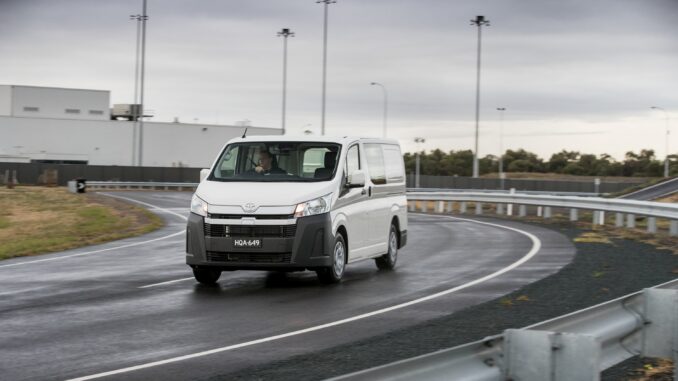
You Can Trust The Numbers
On a local level, the wider van market is dominated by vans of a medium size.
These vehicles have a Gross Vehicle Mass ranging from 2500 to 3500kg. Sales for these fans are far above vehicles that fall below 2400kg and are also above vehicles ranging from 3501 to 8000kg.
According to data from VGACTS, Australia saw medium van sales of 20,215 in 2018. 8,797 large vans were sold in the same year, and 3,129 compact vans were sold.
Van specialists at Credit Capital say, “the purpose of vans is to transfer items and people from one place to the next. This function is a basic one. Still, in order for a van to truly serve the needs of the person behind its wheel, it must also deliver excellent performance, be comfortable to drive, and have excellent fuel economy.”
While taking these factors into consideration, our team of judges decided to test three vans. We drove each vehicle across a test loop numerous times, looking at the vehicle’s brakes, engine, transmission, and dynamic transmission. The vehicles were driven while empty and while carrying a load of 650kg.
Other factors looked at include noise and vibration levels, comfort, and electronic functionality when determining a score.
#1 Ford Transit Custom sits near the top of its class
Even though this van has a power option of 96kW, which is lower than any of the vans we tested, we still found it to be far more responsive than the other vehicles we looked at. Whether or not it’s carrying a heavy load, the engine performs beautifully. With that said, if you don’t use your right foot properly, you may find that it has a sharp throttle response, which can cause issues when driving the vehicle at lower speeds.
The steering wheel is trimmed with leather, which helps to give it a premium feel. We found that it was the best weighted out of the options we looked at.
It has a four-cylinder, 2.0-litre turbo-diesel engine, which complements the six-speed auto transmission very well. Whether going upwards or downwards, we found the shifts to be both responsive and smooth.
If you look at the transmission level, you’ll find a toggle button on the side facing the driver. This means drivers have the option of shifting gears manually. When the transmission is in manual mode, gears will be held by a gearbox even if the driver doesn’t upshift.
We found the suspension to be fairly firm, particularly compared with the Peugeot, which delivers a smoother experience. We found that we were more likely to experience issues when driving at a slower speed. On the bright side, it delivers less bound from the front end than the Peugeot, and it’s also better at handling corners.
#2 The new HiAce from Toyota is a standout
Even though the Toyota HiAce has an impressive 300cc edge over its top competitor, the Hyundai iLoad, it has just a little more torque and power. This means that the unit isn’t likely to be stressed when it’s being driven.
When you take the vehicle out for a drive, you’ll be able to feel how efficiently it handles, even when you’re carrying a larger load. The engine is connected to a six-speed automatic that responds very well. Shifting is always smooth and the vehicle does its job without any issues.
Car insurance company carinsurancequote.net.au says, “this van is one of the heaviest options on the market. It weighs in at 2,288kh, which makes it 246kg heavier than its nearest competitor, the iLoad. When compared to a lighter vehicle, like the Renault Trafic, the difference is much starker. It’s a whopping 479kg heavier”.
In spite of this, the vehicle never feels as if it’s being overburdened. Because it has a powerful engine and gearbox behind it, the extra kilos don’t feel all that noticeable. When it’s out on the road, the HiAce doesn’t feel like it’s being pushed to its limits. Even when travelling over steep terrain, it’s able to move forward without any sort of issue.
#3 The Hyundai iLoad is a dependable option.
When it came to engine capacity, the iLoad came in second to the HiAce. It also came in second place when it came to peak outputs.
Still, with a weight of 2,042kg, we found that the iLoad was also the second heaviest vehicle we tested. Its weight is well above options from Ford, Peugeot, and Renault. It also comes in second place when it comes to fuel economy. It consumes 7.6L/100km.
Thankfully, the weight doesn’t seem to interfere with the turbo-diesel engine’s performance. We found that it delivered the mid-range torque that we were looking for, even though it didn’t feel as refined or as smooth as some of the other options we considered.
The low-end throttle response is on the softer side, but it’s still an accessible vehicle that performs very well.
This vehicle has rear-wheel drive, which makes it similar to the Toyota in some respects. We found that this influenced the way that it handled slightly, but the impact wasn’t significant. In some cases, rear-wheel-drive vans have issues when handling corners. Even when testing this on wet and slippery roads, we didn’t run into this problem.




Be the first to comment